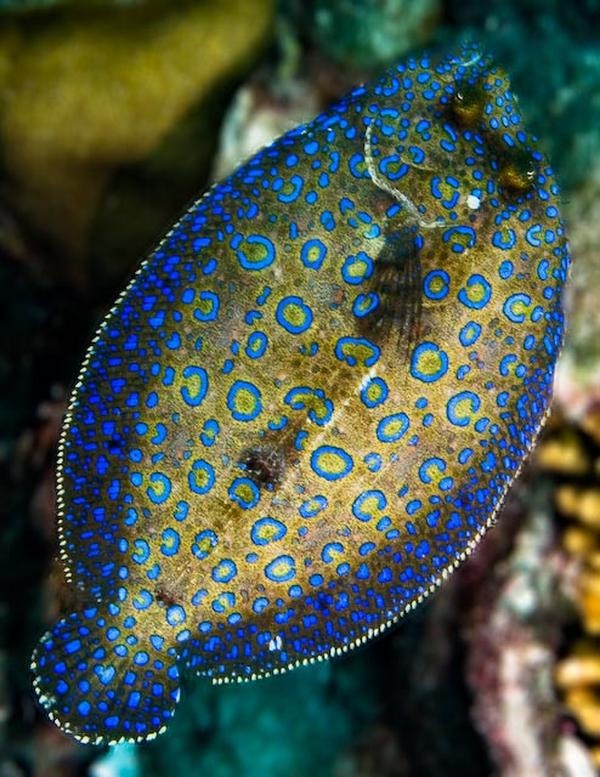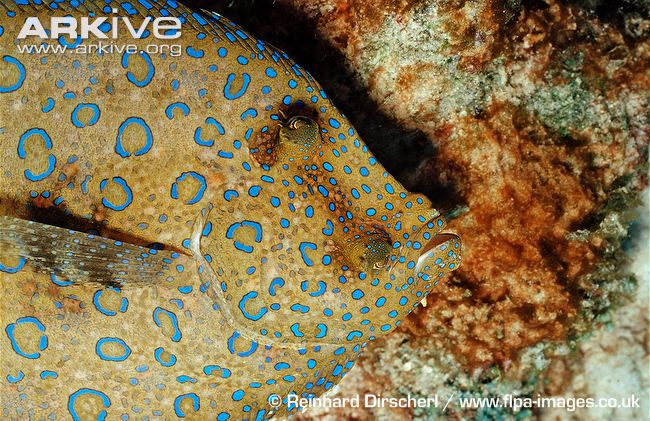
Bothus lunatus
FAMILY
Bothidae
TAXONOMY
Pleuronectes lunatus Linnaeus, 1758, Bahamas.
OTHER COMMON NAMES
French: Rombou lune; Spanish: Lenguado ocelado.
PHYSICAL CHARACTERISTICS
Sinistral flatfish with an oval and moderately deep body.
Rounded to bluntly pointed caudal fin. The dorsal profile of
the snout has a distinct notch above the nostrils, and there is a
stout spine on the snout of adult males (a bony knob in females).
Eyes are relatively large, with the lower eye distinctly
anterior to the upper and with a broad interorbital space that is
conspicuously wider in males. The moderately large and
oblique mouth extends slightly beyond a vertical line through
the anterior margin of the lower eye. Jaws have an irregular
double row of small teeth. Ocular side upper pectoral fin rays
are conspicuously elongate in males. Scales are ctenoid on the
ocular side and cycloid on the blind side. The lateral line has a
steep arch above the pectoral fin. Ocular side is grayish brown,
with numerous bright blue rings and rosettes covering the entire
ocular side and with two to three large blackish spots on
the straight portion of the lateral line. Larger individuals also
have dark transverse bands on the ocular side pectoral fin.
Maximum lengths to about 17.7 in (45 cm), with most individuals
about 13.8 in (35 cm) long.
DISTRIBUTION
Marine coastal waters of the tropical and subtropical western
Atlantic, including Bermuda, the Bahamas, Florida, throughout
the Caribbean, and south to Fernando de Noronha, Brazil.
HABITAT
Shallow waters from the shore to about 213 ft (65 m). Found
chiefly on sandy bottoms, often within or near coral reefs, and
also in sea grass and mangrove habitats.
BEHAVIOR
Diurnally active. Often observed resting on the sandy bottom,
sometimes partially buried in the sand. Occasional specimens
are also observed resting on top of small coral reef tops. When
swimming, they glide along just above the bottom using wavelike
motions. Peacock flounder can change colors rapidly to
blend in with the background.
FEEDING ECOLOGY AND DIET
Visually feeding, ambush predator that eats primarily small
fishes but also consumes crustaceans and octopuses. They often
lie in wait on sand patches adjacent to reef areas to intercept
small fishes undertaking crepuscular migrations between reef
and sea grass habitats. Lizard fishes, snappers, groupers, and
various sharks and stingrays eat peacock flounders.
REPRODUCTIVE BIOLOGY
Off Bonaire in December, peacock flounder spawning took
place just before sunset, with elaborate spawning
BEHAVIOR
observed
for mating pairs. Males and females would approach
each other with pectoral fins held erect to initiate courtship activity.
The male, with its ocular side pectoral fin held erect,
first paralleled the female as they swam above the substrate.
The male then positioned himself underneath the female; with
their snouts touching and the male’s body arched backward,
the pair began a slow rise (about 15 seconds) of about 6.6 ft (2
m) off the bottom, when they simultaneously released their gametes
and rapidly returned to the bottom.
CONSERVATION STATUS
Probably not threatened, but population status is unknown
throughout most of its
DISTRIBUTION
. Because of its size and
food qualities, this species could be susceptible to local overfishing.
SIGNIFICANCE TO HUMANS
Peacock flounder are caught incidentally in artisanal fisheries
throughout their range.
Photo Gallery of - Peacock flounder





 Animalia Life
Animalia Life